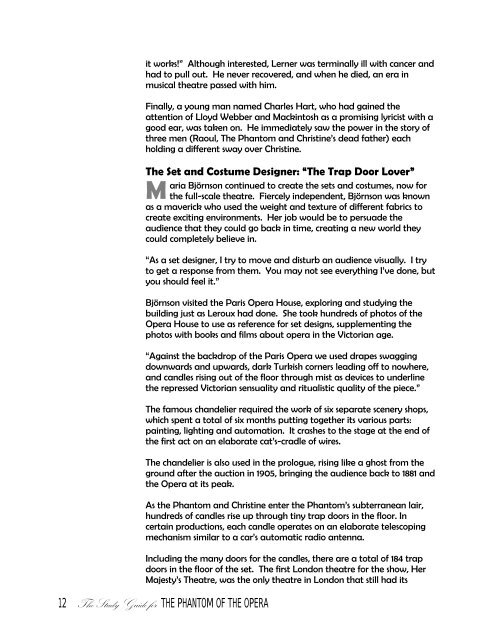Cameron Mackintosh And The Really Useful Theatre ... - Telecharge
Cameron Mackintosh And The Really Useful Theatre ... - Telecharge
Cameron Mackintosh And The Really Useful Theatre ... - Telecharge
Create successful ePaper yourself
Turn your PDF publications into a flip-book with our unique Google optimized e-Paper software.
it works!” Although interested, Lerner was terminally ill with cancer and<br />
had to pull out. He never recovered, and when he died, an era in<br />
musical theatre passed with him.<br />
Finally, a young man named Charles Hart, who had gained the<br />
attention of Lloyd Webber and <strong>Mackintosh</strong> as a promising lyricist with a<br />
good ear, was taken on. He immediately saw the power in the story of<br />
three men (Raoul, <strong>The</strong> Phantom and Christine’s dead father) each<br />
holding a different sway over Christine.<br />
<strong>The</strong> Set and Costume Designer: “<strong>The</strong> Trap Door Lover”<br />
aria Björnson continued to create the sets and costumes, now for<br />
M<br />
the full-scale theatre. Fiercely independent, Björnson was known<br />
as a maverick who used the weight and texture of different fabrics to<br />
create exciting environments. Her job would be to persuade the<br />
audience that they could go back in time, creating a new world they<br />
could completely believe in.<br />
“As a set designer, I try to move and disturb an audience visually. I try<br />
to get a response from them. You may not see everything I’ve done, but<br />
you should feel it.”<br />
Björnson visited the Paris Opera House, exploring and studying the<br />
building just as Leroux had done. She took hundreds of photos of the<br />
Opera House to use as reference for set designs, supplementing the<br />
photos with books and films about opera in the Victorian age.<br />
“Against the backdrop of the Paris Opera we used drapes swagging<br />
downwards and upwards, dark Turkish corners leading off to nowhere,<br />
and candles rising out of the floor through mist as devices to underline<br />
the repressed Victorian sensuality and ritualistic quality of the piece.”<br />
<strong>The</strong> famous chandelier required the work of six separate scenery shops,<br />
which spent a total of six months putting together its various parts:<br />
painting, lighting and automation. It crashes to the stage at the end of<br />
the first act on an elaborate cat’s-cradle of wires.<br />
<strong>The</strong> chandelier is also used in the prologue, rising like a ghost from the<br />
ground after the auction in 1905, bringing the audience back to 1881 and<br />
the Opera at its peak.<br />
As the Phantom and Christine enter the Phantom’s subterranean lair,<br />
hundreds of candles rise up through tiny trap doors in the floor. In<br />
certain productions, each candle operates on an elaborate telescoping<br />
mechanism similar to a car’s automatic radio antenna.<br />
Including the many doors for the candles, there are a total of 184 trap<br />
doors in the floor of the set. <strong>The</strong> first London theatre for the show, Her<br />
Majesty’s <strong>The</strong>atre, was the only theatre in London that still had its<br />
12 <strong>The</strong> Study Guide for THE PHANTOM OF THE OPERA





